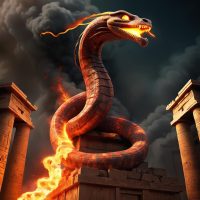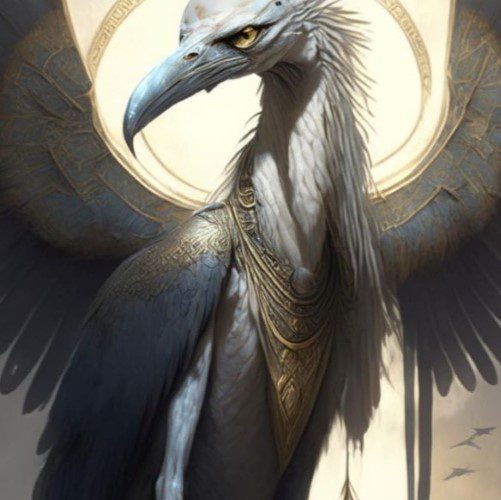Denwen : The Fiery Serpent
Listen
At a glance
| Description | |
|---|---|
| Origin | Egyptian Mythology |
| Classification | Animals |
| Family Members | N/A |
| Region | Egypt |
| Associated With | Fire |
Denwen
Introduction
In the vast and intricate landscape of Egyptian mythology, Denwen emerges as a mysterious and formidable figure. Unlike deities associated with fertility, wisdom, or the afterlife, Denwen embodies the raw, untamed force of fire and destruction. Mentioned in the Pyramid Texts dating back to around 2400 BCE during Egypt’s Old Kingdom, Denwen was feared as a serpent god capable of annihilating even the gods themselves. His myth explores the ancient Egyptian understanding of chaos and cosmic balance, portraying fire not merely as a destructive force but also as an agent of renewal. Although his worship never reached the prominence of gods like Ra, Osiris, or Horus, Denwen’s legend reflects the ancient Egyptian belief that creation and destruction are inseparable elements of the universe’s eternal cycle.
Physical Traits
Denwen is primarily depicted as a colossal serpent or dragon engulfed in flames. His immense, fiery form symbolizes unrestrained power, with the flames surrounding his body representing both danger and divinity. Unlike serpent deities such as Wadjet, the cobra goddess of protection, or Apep (Apophis), the serpent of chaos, Denwen’s imagery is uniquely defined by his mastery of fire. In certain artistic depictions and temple carvings, he appears as a vast coiling serpent whose scales glow with divine heat, a creature capable of setting the heavens ablaze. His visual portrayal captures both awe and fear—an elemental being representing the destructive potential that lies dormant within creation itself. The image of Denwen burning with internal fire became a lasting motif of the destructive serpentine power in Egyptian iconography.
Family
Little is known about Denwen’s divine lineage or familial connections. Unlike other Egyptian gods whose relationships were well defined—such as Isis and Osiris or Nut and Geb—Denwen appears to stand apart. His myth does not record parents, siblings, or consorts, suggesting he may have been conceived as a primordial force rather than a personal deity with relationships. Scholars interpret his isolation as symbolic of his role as an elemental power beyond the confines of divine hierarchy. This independence separates Denwen from more anthropomorphic gods, emphasizing his identity as an embodiment of chaos and cosmic danger. His lack of genealogy reinforces his mythological function as a universal threat rather than a figure of worship or veneration.
Other names
Denwen’s name appears in several transliterations, such as Denwenet or Dnw-n, depending on interpretations of ancient hieroglyphs. He is sometimes referred to as “The Fiery One” or “The Flaming Serpent.” These titles highlight his essence as a god of burning energy and destruction. The consistency of his fiery epithet across sources suggests that ancient Egyptians viewed him as an embodiment of an uncontrollable element rather than a deity with multiple forms or aspects. Unlike other gods with numerous titles reflecting different functions, Denwen’s singular identity underscores his narrow but potent domain—fire as a symbol of both divine wrath and purification.
Powers and Abilities
Denwen’s defining power lies in his control over divine fire. The Pyramid Texts describe him as possessing flames so intense that they could consume both gods and mortals alike. His attempt to unleash this fire upon the divine realm represents one of the earliest recorded myths of rebellion against cosmic order. However, his destructive ambition was thwarted by the spirit of the deceased king, often interpreted as the pharaoh, whose divine intervention restored harmony and balance to the universe. This outcome reinforces the Egyptian worldview that maat (cosmic order) must always triumph over isfet (chaos).
Denwen’s fire embodies duality—it is both a weapon of annihilation and a symbol of renewal. Fire in ancient Egyptian thought was paradoxical: it could destroy impurities but also regenerate and give rise to new life. Denwen’s myth, therefore, can be understood as a metaphor for the delicate equilibrium between destruction and rebirth that sustained the cosmos. His immense power made him an embodiment of existential threat, yet his defeat affirmed the pharaoh’s sacred role as the protector of divine balance.
While Denwen is rarely portrayed as benevolent, later interpretations may have recognized his destructive capacity as part of the natural cycle, akin to how the Nile’s floods destroyed only to renew the land. This complexity mirrors the Egyptian understanding of creation, where chaos and destruction were necessary precursors to order and life.
Modern Day Influence
Although Denwen’s worship faded after the Old Kingdom, his fiery serpent imagery endured across cultures and eras. The archetype of the flame-wreathed serpent or dragon that threatens the gods recurs in multiple mythologies—the Persian Aži Dahāka, the Norse Jörmungandr, and even the Christian serpent of Revelation all echo Denwen’s legacy. His myth may represent one of the earliest known instances of the “dragon of chaos” motif, which has since evolved into countless cultural forms.
In modern times, Denwen’s image resonates within fantasy literature, video games, and digital art as a prototype of the apocalyptic serpent. Characters and creatures inspired by him often serve as symbols of rebellion against divine authority or as personifications of destructive change. His themes of fire, transformation, and cosmic balance are frequently adapted in contemporary storytelling, where dragons embody both terror and wisdom, echoing Denwen’s dual nature.
Art and fashion have also drawn upon his symbolism. The serpent encircled by flames appears in jewelry, tattoos, and artistic motifs as a representation of transformation, immortality, or power. Psychologically, figures like Denwen have been interpreted in Jungian archetypes as manifestations of the destructive unconscious—a force that must be acknowledged and integrated rather than suppressed.
The philosophical and symbolic legacy of Denwen extends into environmental and social discourse as well. The notion of fire as a cycle of destruction and rebirth mirrors humanity’s confrontation with ecological balance—reminding us that unchecked power, whether divine or human, must yield to renewal and harmony.
Related Images
Source
Wilkinson, R. H. (2003). The Complete Gods and Goddesses of Ancient Egypt. Thames & Hudson.
Pinch, G. (2002). Handbook of Egyptian Mythology. ABC-CLIO.
Hornung, E. (1996). Conceptions of God in Ancient Egypt: The One and the Many. Cornell University Press.
Mystery in History. (2024, August 17). Denwen: The Fiery Serpent God Of Ancient Egyptian Mythology. https://mysteryinhistory.com/denwen/
Blackdrago. Dragons of Fame: Denwen. http://www.blackdrago.com/fame/denwen.htm
World History Encyclopedia. (2016, April 13). Egyptian Gods – The Complete List. https://www.worldhistory.org/article/885/egyptian-gods—the-complete-list/
Akhret Notes. (2023, September 30). Denwen – Gods of Ancient Egypt. https://akhretnotes.weebly.com/denwen.html
Wilkinson, R. H. (2003). The Complete Gods And Goddesses Of Ancient Egypt (Full text). https://archive.org/stream/TheCompleteGodsAndGoddessesOfAncientEgypt/The+Complete+Gods+and+Goddesses+of+Ancient+Egypt_djvu.txt
Frequently Asked Questions
What is lorem Ipsum?
I am text block. Click edit button to change this text. Lorem ipsum dolor sit amet, consectetur adipiscing elit. Ut elit tellus, luctus nec ullamcorper mattis, pulvinar dapibus leo.
What is lorem Ipsum?
I am text block. Click edit button to change this text. Lorem ipsum dolor sit amet, consectetur adipiscing elit. Ut elit tellus, luctus nec ullamcorper mattis, pulvinar dapibus leo.
What is lorem Ipsum?
I am text block. Click edit button to change this text. Lorem ipsum dolor sit amet, consectetur adipiscing elit. Ut elit tellus, luctus nec ullamcorper mattis, pulvinar dapibus leo.
What is lorem Ipsum?
I am text block. Click edit button to change this text. Lorem ipsum dolor sit amet, consectetur adipiscing elit. Ut elit tellus, luctus nec ullamcorper mattis, pulvinar dapibus leo.
What is lorem Ipsum?
I am text block. Click edit button to change this text. Lorem ipsum dolor sit amet, consectetur adipiscing elit. Ut elit tellus, luctus nec ullamcorper mattis, pulvinar dapibus leo.








